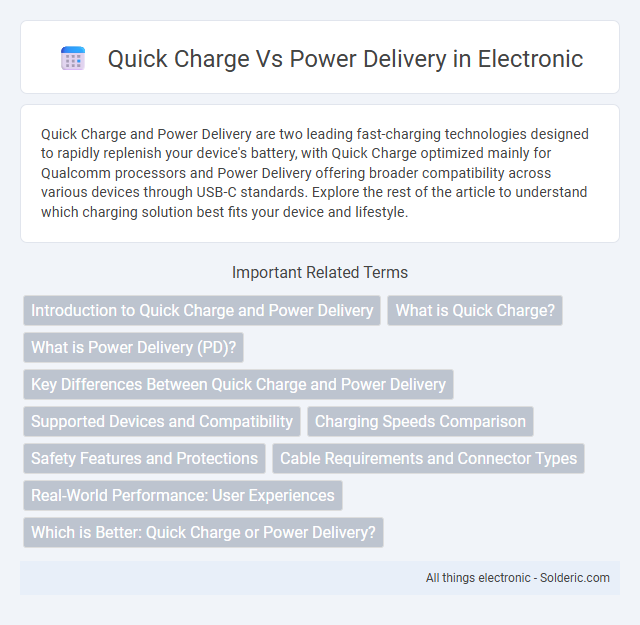Quick Charge and Power Delivery are two leading fast-charging technologies designed to rapidly replenish your device's battery, with Quick Charge optimized mainly for Qualcomm processors and Power Delivery offering broader compatibility across various devices through USB-C standards. Explore the rest of the article to understand which charging solution best fits your device and lifestyle.
Comparison Table
| Feature | Quick Charge (QC) | Power Delivery (PD) |
|---|---|---|
| Developer | Qualcomm | USB Implementers Forum (USB-IF) |
| Voltage Range | 3.6V to 20V | 5V to 20V |
| Max Power Output | Up to 100W (QC 5) | Up to 100W |
| Charging Protocol | Proprietary negotiation between charger and device | Standardized USB-C negotiation |
| Compatibility | Limited to Qualcomm-based devices primarily | Widely supported across devices and brands |
| Connector Type | Varies, often USB-A or USB-C | USB-C |
| Device Support | Android smartphones, select tablets | Smartphones, tablets, laptops, and accessories |
| Advantages | Fast charging for compatible devices, backward compatible with older QC versions | Universal support, higher power for laptops, flexible voltage and current levels |
Introduction to Quick Charge and Power Delivery
Quick Charge is a fast-charging technology developed by Qualcomm, designed to rapidly increase battery charge through higher voltage and current levels. Power Delivery (PD) is a universal fast-charging standard that uses USB-C cables to deliver flexible power up to 100W, optimizing energy transfer for a wide range of devices. Understanding these technologies helps you choose the most efficient charging method for your smartphone or laptop.
What is Quick Charge?
Quick Charge is a proprietary fast-charging technology developed by Qualcomm that enables compatible devices to charge significantly faster than standard USB charging. It uses higher voltage levels and intelligent communication between the charger and device to optimize power transfer, reducing charging time for smartphones and tablets. Quick Charge is widely supported across various Snapdragon-powered devices, making it a popular choice for enhancing battery recharge efficiency.
What is Power Delivery (PD)?
Power Delivery (PD) is a fast-charging protocol that delivers up to 100 watts of power through USB-C connections, allowing for rapid charging of smartphones, laptops, and other electronic devices. It intelligently negotiates power levels between the charger and device, optimizing charging speeds while ensuring safety and compatibility. Your devices can benefit from PD technology by significantly reducing charging time without compromising battery health.
Key Differences Between Quick Charge and Power Delivery
Quick Charge and Power Delivery differ primarily in charging speed, voltage range, and compatibility. Quick Charge, developed by Qualcomm, supports higher voltages up to 20V with proprietary protocols for faster charging on select devices, while Power Delivery (USB PD) uses standardized USB-C technology offering variable voltage from 5V to 20V with wider device compatibility. Power Delivery also enables bidirectional power transfer, making it suitable for charging laptops, smartphones, and peripherals, unlike Quick Charge which focuses mainly on smartphones.
Supported Devices and Compatibility
Quick Charge technology primarily supports Qualcomm Snapdragon devices, including many Android smartphones and tablets, offering fast charging through USB-A and proprietary chargers. Power Delivery (PD) is a universal standard compatible with a wide range of devices such as Apple iPhones, iPads, MacBooks, and various USB-C laptops, providing flexible voltage and current output for faster, safer charging. Compatibility depends on device requirements and charger support, with Power Delivery favored for cross-brand versatility and Quick Charge optimized for Qualcomm-powered systems.
Charging Speeds Comparison
Quick Charge technology, developed by Qualcomm, offers charging speeds up to 27 watts for Quick Charge 4+ and higher in newer versions, enabling devices to reach 50% battery in about 30 minutes. Power Delivery (PD), an open standard supported by USB-C, can deliver up to 100 watts, allowing faster charging for a broader range of devices, including laptops and smartphones. In practical use, Power Delivery tends to provide faster and more versatile charging speeds compared to Quick Charge, especially for higher-capacity devices.
Safety Features and Protections
Quick Charge and Power Delivery both incorporate safety features such as over-voltage, over-current, and thermal protection to prevent damage to devices and chargers. Power Delivery often supports more advanced communication protocols to dynamically adjust voltage and current, providing precise control that enhances your device's safety during fast charging. Quick Charge prioritizes compatibility with a range of devices but may offer fewer customizable safety parameters compared to Power Delivery's adaptive protections.
Cable Requirements and Connector Types
Quick Charge typically uses USB Type-A connectors and standard USB cables, allowing compatibility with a wide range of existing devices, while Power Delivery relies on USB Type-C connectors designed for higher power transfer and faster charging speeds. Your choice of cable significantly impacts performance; Power Delivery requires certified USB-C cables with proper power rating to handle up to 100W, whereas Quick Charge can function with less specialized cables. Ensuring the right connector and cable combination is essential for maximizing charging efficiency and device safety.
Real-World Performance: User Experiences
Quick Charge delivers faster charging speeds on compatible devices, especially with Qualcomm Snapdragon processors, reducing recharge times significantly in everyday use. Power Delivery (PD) offers broader device compatibility and optimized power management, resulting in stable and efficient charging across various brands and gadgets. Users report Quick Charge excels in quick top-ups, while Power Delivery is preferred for consistent, full-cycle charging without overheating issues.
Which is Better: Quick Charge or Power Delivery?
Quick Charge and Power Delivery differ primarily in compatibility and charging speed, with Power Delivery offering broader device support across brands like Apple, Google, and Samsung. Quick Charge is often faster for compatible Qualcomm devices, providing optimized voltage and current levels for rapid charging. Your choice depends on device compatibility and charging needs, with Power Delivery usually offering more versatility across various gadgets.
Quick Charge vs Power Delivery Infographic

 solderic.com
solderic.com